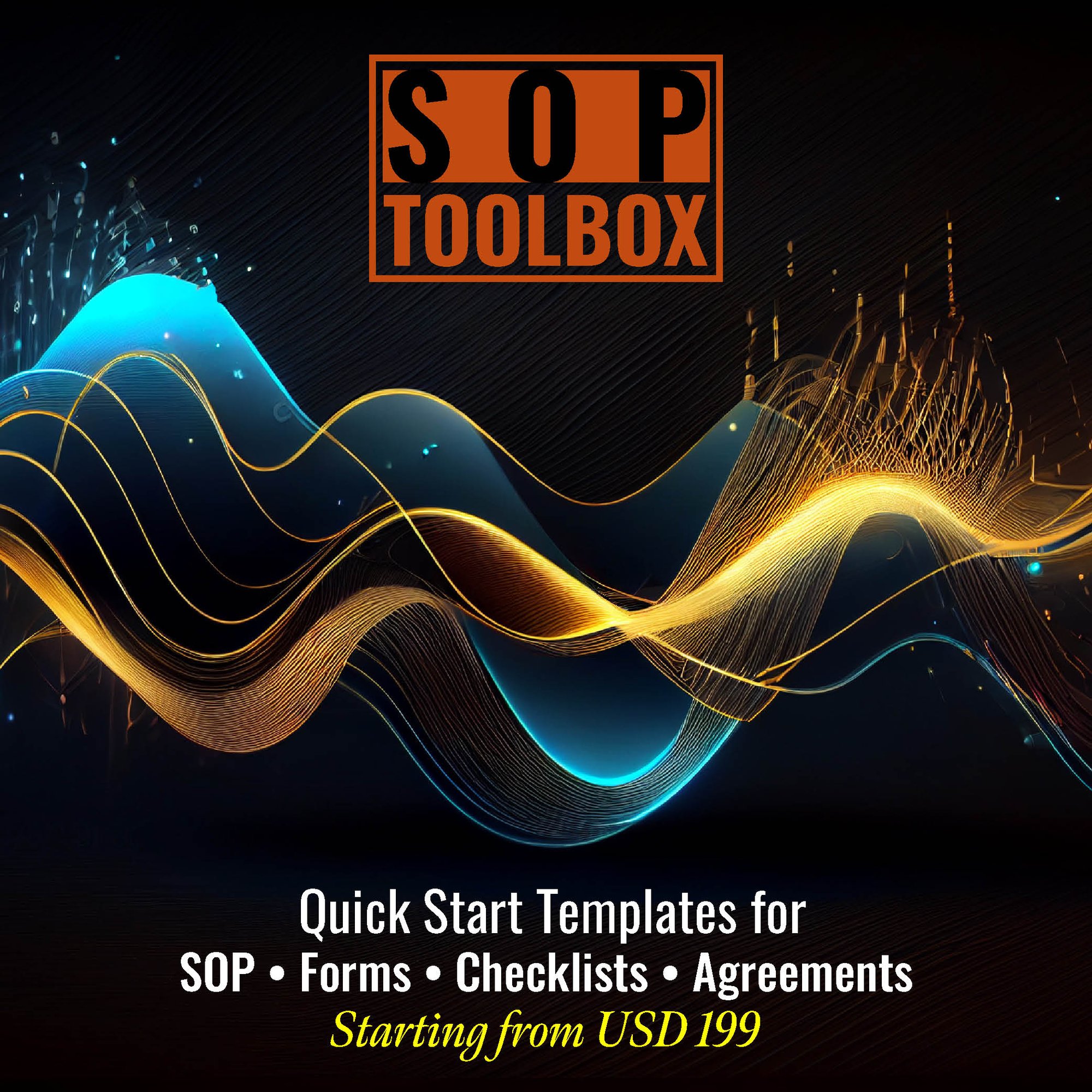The SOP (Standard Operating Procedure) manual for "Solid Waste Combustors and Incinerators" holds critical consequences for environmental sustainability, regulatory compliance, and operational safety. This manual establishes standardized procedures to govern the intricate processes involved in waste combustion, ensuring that operations meet stringent environmental standards.
In the absence of a well-defined SOP manual, there's a heightened risk of environmental harm through air and water pollution, as well as the improper disposal of ash and residues. The consequences may include regulatory violations, legal ramifications, and reputational damage for the facility. Additionally, without clear guidelines on operational procedures, there is an increased risk of accidents, compromising the safety of workers and neighboring communities.
Conversely, a comprehensive SOP manual serves as a safeguard, mitigating environmental impact, ensuring compliance with regulations, and fostering a culture of safety. It provides a reference for personnel training, contributes to efficient waste management, and aids in maintaining public trust. Ultimately, the consequences of lacking or neglecting an SOP manual in this industry can have far-reaching implications for both the environment and the facility's overall performance.
CLICK HERE to download the List of SOPs Document in PDF format. Please share this document with your clients, colleagues and senior officers.
Top 50 Standard Operating Procedures (SOPs) for Solid Waste Combustors and Incinerators
SOP-201-001: Standard Operating Procedure for Facility Introduction and Overview
SOP-201-002: Standard Operating Procedure for Regulatory Compliance
SOP-201-003: Standard Operating Procedure for Emergency Response and Evacuation
SOP-201-004: Standard Operating Procedure for Waste Acceptance Criteria
SOP-201-005: Standard Operating Procedure for Waste Characterization and Segregation
SOP-201-006: Standard Operating Procedure for Handling Hazardous Waste
SOP-201-007: Standard Operating Procedure for Material Handling and Storage
SOP-201-008: Standard Operating Procedure for Combustion Chamber Operation
SOP-201-009: Standard Operating Procedure for Heat Recovery Systems
SOP-201-010: Standard Operating Procedure for Air Pollution Control Devices

SOP-201-011: Standard Operating Procedure for Continuous Emissions Monitoring
SOP-201-012: Standard Operating Procedure for Ash Handling and Disposal
SOP-201-013: Standard Operating Procedure for Routine Maintenance and Inspections
SOP-201-014: Standard Operating Procedure for Major Equipment Overhaul
SOP-201-015: Standard Operating Procedure for Instrument Calibration
SOP-201-016: Standard Operating Procedure for Operator Training and Certification
SOP-201-017: Standard Operating Procedure for Recordkeeping and Documentation
SOP-201-018: Standard Operating Procedure for Odor Control
SOP-201-019: Standard Operating Procedure for Noise Control
SOP-201-020: Standard Operating Procedure for Dust Control
SOP-201-021: Standard Operating Procedure for Process Optimization
SOP-201-022: Standard Operating Procedure for Shutdown and Startup Procedures
SOP-201-023: Standard Operating Procedure for Ash Sampling and Analysis
SOP-201-024: Standard Operating Procedure for Flue Gas Monitoring
SOP-201-025: Standard Operating Procedure for Residue Management
SOP-201-026: Standard Operating Procedure for Waste Heat Recovery
SOP-201-027: Standard Operating Procedure for Emergency Shutdown Procedures
SOP-201-028: Standard Operating Procedure for Fire Prevention and Control
SOP-201-029: Standard Operating Procedure for Personnel Protective Equipment (PPE)
SOP-201-030: Standard Operating Procedure for Air Emissions Reporting

SOP-201-031: Standard Operating Procedure for Stack Inspection and Maintenance
SOP-201-032: Standard Operating Procedure for Equipment Decommissioning
SOP-201-033: Standard Operating Procedure for Waste Incineration Testing
SOP-201-034: Standard Operating Procedure for Incinerator Ash Sampling
SOP-201-035: Standard Operating Procedure for Environmental Monitoring
SOP-201-036: Standard Operating Procedure for Quality Assurance and Control
SOP-201-037: Standard Operating Procedure for Operator Health and Safety
SOP-201-038: Standard Operating Procedure for Hot Work Permitting
SOP-201-039: Standard Operating Procedure for Spill Response and Cleanup
SOP-201-040: Standard Operating Procedure for Public Communication and Outreach
SOP-201-042: Standard Operating Procedure for Waste Transportation and Handling
SOP-201-043: Standard Operating Procedure for Flue Gas Desulfurization
SOP-201-044: Standard Operating Procedure for Scrubber Maintenance
SOP-201-045: Standard Operating Procedure for Ash Landfill Management
SOP-201-046: Standard Operating Procedure for Energy Recovery Systems
SOP-201-047: Standard Operating Procedure for Combustor Residue Analysis
SOP-201-048: Standard Operating Procedure for Continuous Improvement Initiatives
SOP-201-049: Standard Operating Procedure for Training Program Evaluation
SOP-201-050: Standard Operating Procedure for Regulatory Reporting

.jpg?width=645&height=337&name=Standard%20Operating%20Procedure%20-%20SOP%20ToolBox%20(1).jpg)
SOP ToolBox: If you are reading these lines, I am sure you are looking for Standard Operating Procedure guidelines or SOPs itself. In both the cases, searching in internet will not be yielding any great help. Because no company shares their SOP Development Process and certainly don’t share their SOP Documents. The best way to develop an SOP is creating one for yourself. At Fhyzics, we write SOPs day-in and day-out for companies across the globe including some of the Fortune 500 organisations. Our charge ranges from USD 5000 to USD 50000 depending upon the number of processes to be covered. Certainly, this is not affordable to small and mid-size organisations. Hence, we decided to create this SOP ToolBox to disseminate our 8-Step SOP Development Life-Cycle and best practices at an unbelievably low price.
I always say, writing an SOP is somewhere between art and science. So far you may be clueless on where to start and how to progress on an SOP? This will not be the case after you diligently go through this SOP ToolBox. We have summarised all our secrets here to get you started and to deliver a stunning SOP to your management.
Industry’s Subsector:
- Combustors, non-hazardous solid waste
- Garbage disposal combustors or incinerators
- Incinerators, non-hazardous solid waste
- Power generation non-hazardous solid waste combustor or incinerator electric
- Refuse disposal combustors or incinerators
- Rubbish disposal combustors or incinerators
- Solid waste combustors or incinerators
- Trash disposal combustors or incinerators
- Waste disposal combustors or incinerators
- Solid Waste Generation
- Solid Waste Collection
- Transportation
- Storage
- Segregation of Wastes
- Home Separation for Recycling
- Disposal Method
- Hand scrapers, shovels, brooms, washers
- Tractor scraper blades
- Lawn and garden size tractor scraping
- Tractor front-end loaders
- Skidsteer and articulated loaders
- All-wheel drive front-end loader
- Motor grader
- Elevating type box scrapers
- Mechanical scrapers for gutters and alleys
- Conveyors and stackers
- Flushed gutters and alleys
- Air-pressure and vacuum waste pumping
- Piston-plunger pumps
- Storage interior accessing
- Storage exterior accessing
- Storage fencing with gates
- Covers, drainage, and runoff control
- Agitators, stirrers, mixers
- Aerators
- Separators
- Dehydrator, incinerator, renderors
- Hauled waste spreading equipment
- Soil injection waste spreading equipment
- Pumped waste spreading
- Biogas production equipment
- Safety protection equipment
- Gases and confined space entry
- Odor detection/measurement equipment
- International Organization for Standardization-TC 297- https://www.iso.org/committee/5902445.html
- International Organization for Standardization- 13.030- https://www.iso.org/ics/13.030/x/
- ASTM International|ASTM C1571-03(2012)- https://www.astm.org/Standards/C1571.htm#:~:text=ASTM%20C1571%20%2D%2003(2012),for%20Thermal%20Treatment%20(Withdrawn%202018)
- The International Solid Waste Association- https://www.iswa.org/
- Waste & Recycling Industry Associations- https://wasteadvantagemag.com/industry-associations/
- Covanta| New Jersey, United States| http://www.covanta.com/
- Biffa| Buckinghamshire, United Kingdom| https://www.biffa.co.uk/
- Veolia| Aubervilliers, France| https://www.veolia.com/en
- SUEZ|Paris, France| https://www.suez.com/en
- Waste Management | Texas, United States| http://www.wm.com/
- Hitachi Zosen Corporation|Osaka, Japan| http://www.hz-inova.com/cms/
- Clean Harbors|Massachusetts, United States| http://www.cleanharbors.com/
- Remondis| Lünen, Germany| https://www.remondis.com/en/home/
- Advanced Disposal Services| Florida, United States| https://www.advanceddisposal.com/
- Republic Services| Arizona, United States| http://www.republicservices.com/
- Waste Advantage Magazine- https://wasteadvantagemag.com/
- Waste Today Magazine- https://www.wastetodaymagazine.com/
- Resource Recycling Magazine- https://resource-recycling.com/recycling/magazine/
- Journal-Waste Management| Elsevier- https://resource-recycling.com/recycling/magazine/
- Waste360 Magazine- https://www.waste360.com/waste360-magazine
- Recent Waste Management Articles| Elsevier- https://www.journals.elsevier.com/waste-management/recent-articles
Our SOP Templates’ clients are from the following States and Countries:
Alabama, Alaska, Arizona, Arkansas, California, Colorado, Connecticut, Delaware, Florida, Georgia, Hawaii, Idaho, Illinois, Indiana, Iowa, Kansas, Kentucky, Louisiana, Maine, Maryland, Massachusetts, Michigan, Minnesota, Mississippi, Missouri, Montana, Nebraska, Nevada, New Hampshire, New Jersey, New Mexico, New York, North Carolina, North Dakota, Ohio, Oklahoma, Oregon, Pennsylvania, Rhode Island, South Carolina, South Dakota, Tennessee, Texas, Utah, Vermont, Virginia, Washington, West Virginia, Wisconsin, Wyoming.
Afghanistan, Albania, Algeria, Andorra, Angola, Antigua and Barbuda, Argentina, Armenia, Australia, Austria, Azerbaijan, Bahamas, Bahrain, Bangladesh, Barbados, Belarus, Belgium, Belize, Benin, Bhutan, Bolivia, Bosnia and Herzegovina, Botswana, Brazil, Brunei Darussalam, Bulgaria, Burkina Faso, Burundi, Cabo Verde, Cambodia, Cameroon, Canada, Central African Republic, Chad, Chile, China, Colombia, Comoros, Congo (Republic of the), Costa Rica, Croatia, Cuba, Cyprus, Czech Republic (Czechia), Democratic People’s Republic of Korea (North Korea), Democratic Republic of the Congo, Denmark, Djibouti, Dominica, Dominican Republic, Ecuador, Egypt, El Salvador, Equatorial Guinea, Eritrea, Estonia, Eswatini, Ethiopia, Fiji, Finland, France, Gabon, Gambia, Georgia, Germany, Ghana, Greece, Grenada, Guatemala, Guinea, Guinea-Bissau, Guyana, Haiti, Honduras, Hungary, Iceland, India, Indonesia, Iran, Iraq, Ireland, Israel, Italy, Jamaica, Japan, Jordan, Kazakhstan,Kenya, Kiribati, Kuwait, Kyrgyzstan, Lao People’s Democratic Republic (Laos), Latvia, Lebanon, Lesotho, Liberia, Libya, Liechtenstein, Lithuania, Luxembourg, Madagascar, Malawi, Malaysia, Maldives, Mali, Malta, Marshall Islands, Mauritania, Mauritius, Mexico, Micronesia (Federated States of), Moldova, Monaco, Mongolia, Montenegro, Morocco, Mozambique, Myanmar (Burma), Namibia, Nauru, Nepal, Netherlands, New Zealand, Nicaragua, Niger, Nigeria, North Macedonia (formerly Macedonia), Norway, Oman, Pakistan, Palau, Panama, Papua New Guinea, Paraguay, Peru, Philippines, Poland, Portugal, Qatar, Republic of Korea (South Korea), Republic of the Congo, Romania, Russian Federation (Russia), Rwanda, Saint Kitts and Nevis, Saint Lucia, Saint Vincent and the Grenadines, Samoa, San Marino, Sao Tome and Principe, Saudi Arabia, Senegal, Serbia, Seychelles, Sierra Leone, Singapore, Slovakia, Slovenia, Solomon Islands, Somalia, South Africa, South Sudan, Spain, Sri Lanka, Sudan, Suriname, Sweden, Switzerland, Syrian Arab Republic (Syria), Tajikistan, Thailand, Timor-Leste, Togo, Tonga, Trinidad and Tobago, Tunisia, Turkey, Turkmenistan, Tuvalu, Uganda, Ukraine, United Arab Emirates, United Kingdom of Great Britain and Northern Ireland, United Republic of Tanzania, United States of America, Uruguay, Uzbekistan, Vanuatu, Venezuela, Viet Nam, Yemen, Zambia, Zimbabwe.
Fhyzics supports organisations in developing the following documentations:
Standard Operating Procedures (SOPs), Work Instructions, Policies and Procedures, Process Flow Diagrams, Job Descriptions, Training Manuals, Employee Handbooks, Compliance Guidelines, Quality Assurance Manuals, Health and Safety Procedures, Risk Management Plans, Business Continuity Plans, Internal Audit Procedures, Incident Reporting Forms, Performance Management Guidelines, Change Management Procedures, Vendor Management Guidelines, Customer Service Protocols, IT Security Policies, IT Support Documentation, Disaster Recovery Plans, Operational Checklists, Data Management Policies, Confidentiality Agreements, Non-Disclosure Agreements, Employee Onboarding Procedures, Employee Exit Procedures, Performance Appraisal Forms, Employee Code of Conduct, Conflict Resolution Procedures, Product Development SOPs, Supply Chain Management Guidelines, Procurement Guidelines, Inventory Management SOPs, Shipping and Receiving Procedures, Production Scheduling SOPs, Maintenance Procedures, Equipment Calibration Documents, Environmental Compliance Documentation, Sustainability Policies, Customer Feedback Forms, Marketing Strategies, Advertising Guidelines, Brand Management Guidelines, Product Packaging SOPs, Laboratory Testing Procedures, Regulatory Compliance Documentation, Tax and Accounting Procedures, Contract Management Procedures, Legal Compliance Guidelines, Financial Reporting Procedures, Budgeting Procedures, Internal Control Procedures, Fraud Prevention Policies, Asset Management Guidelines, Purchase Order Procedures, Sales and Distribution Guidelines, Client Contracts, Customer Return Policies, Internal Communication Protocols, Vendor Evaluation Forms, Product Safety Standards, Workplace Health and Safety Standards, Public Relations Procedures, Social Media Management Guidelines, Crisis Management Plans, Employee Grievance Procedures, Privacy and Data Protection Policies, Digital Transformation Guidelines, Innovation Management Procedures, Continuous Improvement Guidelines, Strategic Planning Documents, Corporate Social Responsibility (CSR) Guidelines, Audit Trails and Records, Employee Training and Development Records, Succession Planning Documents, Talent Acquisition Procedures, Team Collaboration Protocols, Employee Benefit Plans, Workplace Diversity Guidelines, Time and Attendance Tracking, Payroll Procedures, Employee Leave Policies, Conflict of Interest Policy, Emergency Response Procedures, Environmental Impact Assessment Procedures, Transportation and Logistics Procedures, Inventory Control Forms, Warehouse Management Guidelines, Product Lifecycle Management SOPs, Customer Satisfaction Surveys, Third-Party Risk Assessment Guidelines, Technology Adoption Policies, Software Licensing Guidelines, Security Incident Response Procedures, Supply Chain Risk Management Policies, Product Recall Procedures, Food Safety Guidelines, Employee Wellness Programs, Workplace Ergonomics Guidelines.
















